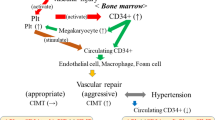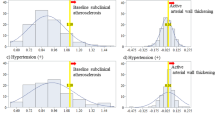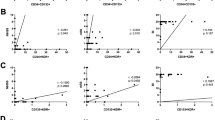Abstract
Background Endothelial dysfunction is an early manifestation of atherosclerotic disease. Circulating cells that express CD34, including endothelial and hematopoietic progenitor cells, might play a part in the development and progression of atherosclerosis. The aim of this study was to evaluate the association between coronary endothelial dysfunction and concentrations of circulating CD34+ cell subsets.
Methods Intracoronary acetylcholine challenge was used to test for coronary endothelial dysfunction in 57 consecutive patients scheduled to undergo diagnostic coronary angiography and with no signs of substantial obstructive lesions. Mononuclear cells were extracted from whole blood samples taken from all patients, analyzed by flow cytometry for CD14, CD34, CD133, CD45, and vascular endothelial growth factor receptor 2 (VEGFR2), and cultured for functional analysis.
Results Compared with patients with normal coronary endothelial function, in those with coronary endothelial dysfunction, the number of circulating CD34+/CD45dim/VEGFR2− cells, CD34+/CD45dim/CD133+/VEGFR2− cells and colony-forming units were reduced. Concentrations of CD34+/CD45−/VEGFR2+ cells did not differ between groups.
Conclusions Regulation of CD34+ cell subsets seems to differ between patients with coronary endothelial dysfunction and those with normal coronary endothelial function. Changes in specific circulating progenitor cell subsets might, therefore, be an early manifestation of atherosclerosis.
This is a preview of subscription content, access via your institution
Access options
Subscribe to this journal
Receive 12 print issues and online access
$209.00 per year
only $17.42 per issue
Buy this article
- Purchase on Springer Link
- Instant access to full article PDF
Prices may be subject to local taxes which are calculated during checkout





Similar content being viewed by others
References
Bonetti PO et al. (2003) Endothelial dysfunction: a marker of atherosclerotic risk. Arterioscler Thromb Vasc Biol 23: 168–175
Suwaidi JA et al. (2000) Long-term follow-up of patients with mild coronary artery disease and endothelial dysfunction. Circulation 101: 948–954
Hasdai D et al. (1997) Coronary endothelial dysfunction in humans is associated with myocardial perfusion defects. Circulation 96: 3390–3395
Kunz GA et al. (2006) Circulating endothelial progenitor cells predict coronary artery disease severity. Am Heart J 152: 190–195
Stump MM et al. (1963) Endothelium grown from circulating blood on isolated intravascular dacron hub. Am J Pathol 43: 361–363
Gunsilius E et al. (2000) Evidence from a leukaemia model for maintenance of vascular endothelium by bone-marrow-derived endothelial cells. Lancet 355: 1688–1691
Werner N et al. (2002) Bone marrow-derived progenitor cells modulate vascular reendothelialization and neointimal formation: effect of 3-hydroxy-3-methylglutaryl coenzyme A reductase inhibition. Arterioscler. Thromb Vasc Biol 22: 1567–1572
Sabin FR (2002) Preliminary note on the differentiation of angioblasts and the method by which they produce blood-vessels, blood-plasma and red blood-cells as seen in the living chick. 1917. J. Hematother Stem Cell Res 11: 5–7
Peichev M et al. (2000) Expression of VEGFR-2 and AC133 by circulating human CD34(+) cells identifies a population of functional endothelial precursors. Blood 95: 952–958
Zambidis ET et al. (2007) Emergence of human angiohematopoietic cells in normal development and from cultured embryonic stem cells. Ann N Y Acad Sci 1106: 223–232
Werner N et al. (2005) Circulating endothelial progenitor cells and cardiovascular outcomes. N Engl J Med 353: 999–1007
Vasa M et al. (2001) Number and migratory activity of circulating endothelial progenitor cells inversely correlate with risk factors for coronary artery disease. Circ Res 89: E1–E7
Hill JM et al. (2003) Circulating endothelial progenitor cells, vascular function, and cardiovascular risk. N Engl J Med 348: 593–600
Schmidt-Lucke C et al. (2005) Reduced number of circulating endothelial progenitor cells predicts future cardiovascular events: proof of concept for the clinical importance of endogenous vascular repair. Circulation 111: 2981–2987
Murphy C et al. (2007) Vascular dysfunction and reduced circulating endothelial progenitor cells in young healthy UK South Asian men. Arterioscler Thromb Vasc Biol 27: 936–942
Werner N et al. (2007) Endothelial progenitor cells correlate with endothelial function in patients with coronary artery disease. Basic Res Cardiol 102: 565–571
Ingram DA et al. (2005) Unresolved questions, changing definitions, and novel paradigms for defining endothelial progenitor cells. Blood 106: 1525–1531
Doyle B et al. (2006) Endothelial progenitor cells. Endothelium 13: 403–410
Guven H et al. (2006) The number of endothelial progenitor cell colonies in the blood is increased in patients with angiographically significant coronary artery disease. J. Am Coll Cardiol 48: 1579–1587
Shmilovich H et al. (2007) Circulating endothelial progenitor cells in patients with cardiac syndrome X. Heart 93: 1071–1076
Huang P et al. (2007) Vascular endothelial function and circulating endothelial progenitor cells in patients with cardiac syndrome. Heart 93: 1064–1070
Sutherland DR et al. (1996) The ISHAGE guidelines for CD34+ cell determination by flow cytometry. International Society of Hematotherapy and Graft Engineering. J Hematother 5: 213–226
Timmermans F et al. (2007) Endothelial outgrowth cells are not derived from CD133+ cells or CD45+ hematopoietic precursors. Arterioscler Thromb Vasc Biol 27: 1572–1579
Duda DG et al. (2007) A protocol for phenotypic detection and enumeration of circulating endothelial cells and circulating progenitor cells in human blood. Nat Protoc 2: 805–810
Al Suwaidi J et al. (1999) Measuring maximal percent area stenosis poststent placement with intracoronary Doppler and the continuity equation and correlation with intracoronary ultrasound and angiography. Am J Cardiol 84: 650–654
Yang EH et al. (2006) Lipoprotein-associated phospholipase A2 is an independent marker for coronary endothelial dysfunction in humans. Arterioscler Thromb Vasc Biol 26: 106–111
Gulati R et al. (2003) Diverse origin and function of cells with endothelial phenotype obtained from adult human blood. Circ Res 93: 1023–1025
WinMDI version 2.8 (The Scripps Research Institute, La Jolla, CA, USA)
JMP version 6.0 (SAS Institute, Inc., Cary, NC, USA)
Asahara T et al. (1997) Isolation of putative progenitor endothelial cells for angiogenesis. Science 275: 964–967
Yoder MC et al. (2007) Redefining endothelial progenitor cells via clonal analysis and hematopoietic stem/progenitor cell principals. Blood 109: 1801–1809
Lin Y et al. (2000) Origins of circulating endothelial cells and endothelial outgrowth from blood. J Clin Invest 105: 71–77
Case J et al. (2007) Human CD34+AC133+VEGFR-2+ cells are not endothelial progenitor cells but distinct, primitive hematopoietic progenitors. Exp Hematol 35: 1109–1118
Torsney E et al. (2007) Characterisation of progenitor cells in human atherosclerotic vessels. Atherosclerosis 191: 259–264
Urbich C et al. (2005) Soluble factors released by endothelial progenitor cells promote migration of endothelial cells and cardiac resident progenitor cells. J Mol Cell Cardiol 39: 733–742
Bautz F et al. (2000) Expression and secretion of vascular endothelial growth factor-A by cytokine-stimulated hematopoietic progenitor cells. Possible role in the hematopoietic microenvironment. Exp Hematol 28: 700–706
Hildbrand P et al. (2004) The role of angiopoietins in the development of endothelial cells from cord blood CD34+ progenitors. Blood 104: 2010–2019
Zengin E et al. (2006) Vascular wall resident progenitor cells: a source for postnatal vasculogenesis. Development 133: 1543–1551
Acknowledgements
This study was funded by the National Institutes of Health (HL76611, 75566) and the Minnesota Partnership for Biotechnology and Medical Genomics. Special thanks are given to JE Tarara and staff at the Mayo Clinic Flow Cytometry Core Facility for their assistance with processing the samples, to T Hoskin and D Schroeder for biostatistical advice, and to ME Crouch for her secretarial support.
Author information
Authors and Affiliations
Corresponding author
Ethics declarations
Competing interests
The authors declare no competing financial interests.
Rights and permissions
About this article
Cite this article
Boilson, B., Kiernan, T., Harbuzariu, A. et al. Circulating CD34+ cell subsets in patients with coronary endothelial dysfunction. Nat Rev Cardiol 5, 489–496 (2008). https://doi.org/10.1038/ncpcardio1277
Received:
Accepted:
Published:
Issue Date:
DOI: https://doi.org/10.1038/ncpcardio1277
This article is cited by
-
Endogenous PCSK9 may influence circulating CD45neg/CD34bright and CD45neg/CD34bright/CD146neg cells in patients with type 2 diabetes mellitus
Scientific Reports (2021)
-
The effect of polyphenol-rich chardonnay seed supplements on peripheral endothelial function
European Journal of Nutrition (2020)
-
Circulating hematopoietic stem cell count is a valuable predictor of prematurity complications in preterm newborns
BMC Pediatrics (2012)
-
Effects of calcium channel blockers on glucose tolerance, inflammatory state, and circulating progenitor cells in non-diabetic patients with essential hypertension: a comparative study between Azelnidipine and amlodipine on Glucose tolerance and ENdothelial function - a crossover Trial (AGENT)
Cardiovascular Diabetology (2011)
-
Smoking decreases the level of circulating CD34+ progenitor cells in young healthy women - a pilot study
BMC Women's Health (2010)



